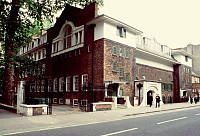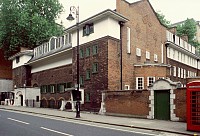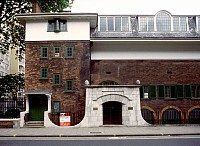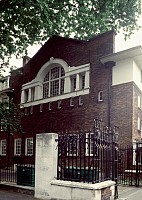

| Mary Ward House in Tavistock Place is the headquarters of the National Institute for Social Work in London. The Setlement was established on the initiative of Mary Ward, who wrote more than 25 novels under the name of Mrs Humphry Ward, the most famous of which is Robert Elsmere (1888). The Settlement is credited with a number of innovations: educational classrooms for children with disabilities, the development of play centers for children, and the creation of a structure whereby middle-class professionals and working-class members of the local community could work together to improve the community. | ||

|

|
The front facade from an angleThe plain brick exterior is symmetrical with projecting wings at each end, each with an entrance with deep projecting eaves. The stair windows form "opposing diagonals at each end of the composition" (Davey 145). |
The facade is characterized by unique and varied fenestration. The white arched opening is the entrance to the residential section of the building. The stone eggs on top of the porch are symbols of creation.Windows and portals on the front facade | ||
| The white stone structure "grows smoothly out of the curves of the balustrading to form a massive stone block projecting forward to the pavement, penetrated by a broad welcoming arched opening" (Davey 145). | 
|

|

|

|
Left: the Venetian window on the side; center: the side door"Wedged into the surface of the building is the side door with projecting canopy and its stepped stonework, all very good indeed" (Jones and Woodward 122). |
 Click here to return to index of art historical sites.
Click here to return to index of art historical sites.
 Click here to return to index of artists and architects.
Click here to return to index of artists and architects.
 Click here to return to chronological index.
Click here to return to chronological index.
 Click here to see the home page of Bluffton University.
Click here to see the home page of Bluffton University.
